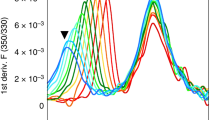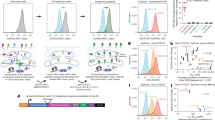Abstract
Major histocompatibility complex (MHC) class I molecules associate with a variety of peptide ligands during biosynthesis and present these ligands on the cell surface for recognition by cytotoxic T cells. We have designed conditional MHC ligands that form stable complexes with MHC molecules but degrade on command, by exposure to a defined photostimulus. 'Empty MHC molecules' generated in this manner can be loaded with arrays of peptide ligands to determine MHC binding properties and to monitor antigen-specific T-cell responses in a high-throughput manner. We document the value of this approach by identifying cytotoxic T-cell epitopes within the H5N1 influenza A/Vietnam/1194/04 genome.
This is a preview of subscription content, access via your institution
Access options
Subscribe to this journal
Receive 12 print issues and online access
$209.00 per year
only $17.42 per issue
Buy this article
- Purchase on Springer Link
- Instant access to full article PDF
Prices may be subject to local taxes which are calculated during checkout




Similar content being viewed by others
References
Ljunggren, H.G. et al. Empty MHC class I molecules come out in the cold. Nature 346, 476–480 (1990).
Schumacher, T.N. et al. Direct binding of peptide to empty MHC class I molecules on intact cells and in vitro. Cell 62, 563–567 (1990).
Fremont, D.H., Matsumura, M., Stura, E.A., Peterson, P.A. & Wilson, I.A. Crystal structures of two viral peptides in complex with murine MHC class I H-2Kb. Science 257, 919–927 (1992).
Silver, M.L., Guo, H.C., Strominger, J.L. & Wiley, D.C. Atomic structure of a human MHC molecule presenting an influenza virus peptide. Nature 360, 367–369 (1992).
Bouvier, M. & Wiley, D.C. Importance of peptide amino and carboxyl termini to the stability of MHC class I molecules. Science 265, 398–402 (1994).
Schumacher, T.N. et al. Peptide selection by MHC class I molecules. Nature 350, 703–706 (1991).
Falk, K., Rotzschke, O., Stevanovic, S., Jung, G. & Rammensee, H.G. Allele-specific motifs revealed by sequencing of self-peptides eluted from MHC molecules. Nature 351, 290–296 (1991).
Altman, J.D. et al. Phenotypic analysis of antigen-specific T lymphocytes. Science 274, 94–96 (1996).
Soen, Y., Chen, D.S., Kraft, D.L., Davis, M.M. & Brown, P.O. Detection and characterization of cellular immune responses using peptide-MHC microarrays. PLoS Biol. 1, E65 (2003).
Stone, J.D., Demkowicz, W.E., Jr & Stern, L.J. HLA-restricted epitope identification and detection of functional T cell responses by using MHC-peptide and costimulatory microarrays. Proc. Natl. Acad. Sci. USA 102, 3744–3749 (2005).
Yee, C., Savage, P.A., Lee, P.P., Davis, M.M. & Greenberg, P.D. Isolation of high avidity melanoma-reactive CTL from heterogeneous populations using peptide-MHC tetramers. J. Immunol. 162, 2227–2234 (1999).
Falkenburg, J.H., van de Corput, L., Marijt, E.W. & Willemze, R. Minor histocompatibility antigens in human stem cell transplantation. Exp. Hematol. 31, 743–751 (2003).
Moss, P. & Rickinson, A. Cellular immunotherapy for viral infection after HSC transplantation. Nat. Rev. Immunol. 5, 9–20 (2005).
Peggs, K.S. et al. Adoptive cellular therapy for early cytomegalovirus infection after allogeneic stem-cell transplantation with virus-specific T-cell lines. Lancet 362, 1375–1377 (2003).
Rooney, C.M. et al. Use of gene-modified virus-specific T lymphocytes to control Epstein-Barr-virus-related lymphoproliferation. Lancet 345, 9–13 (1995).
Walter, E.A. et al. Reconstitution of cellular immunity against cytomegalovirus in recipients of allogeneic bone marrow by transfer of T-cell clones from the donor. N. Engl. J. Med. 333, 1038–1044 (1995).
Cobbold, M. et al. Adoptive transfer of cytomegalovirus-specific CTL to stem cell transplant patients after selection by HLA-peptide tetramers. J. Exp. Med. 202, 379–386 (2005).
Bosques, C.J. & Imperiali, B. Photolytic control of peptide self-assembly. J. Am. Chem. Soc. 125, 7530–7531 (2003).
Wieboldt, R. et al. Synthesis and characterization of photolabile o-nitrobenzyl derivatives of urea. J. Org. Chem. 67, 8827–8831 (2002).
Garboczi, D.N., Hung, D.T. & Wiley, D.C. HLA-A2-peptide complexes: refolding and crystallization of molecules expressed in Escherichia coli and complexed with single antigenic peptides. Proc. Natl. Acad. Sci. USA 89, 3429–3433 (1992).
Sulyok, G.A. et al. Solid-phase synthesis of a nonpeptide RGD mimetic library: new selective αvβ3 integrin antagonists. J. Med. Chem. 44, 1938–1950 (2001).
Rammensee, H.G., Bachmann, J., Emmerich, N.N., Bachor, O.A. & Stevanovic, S. SYFPEITHI: database for MHC ligands and peptide motifs. Immunogenetics 50, 213–219 (1999).
Valmori, D. et al. Enhanced generation of specific tumor-reactive CTL in vitro by selected Melan-A/MART-1 immunodominant peptide analogues. J. Immunol. 160, 1750–1758 (1998).
Greten, T.F. et al. Direct visualization of antigen-specific T cells: HTLV-1 Tax11–19- specific CD8+ T cells are activated in peripheral blood and accumulate in cerebrospinal fluid from HAM/TSP patients. Proc. Natl. Acad. Sci. USA 95, 7568–7573 (1998).
Oelke, M. & Schneck, J.P. HLA-Ig-based artificial antigen-presenting cells: setting the terms of engagement. Clin. Immunol. 110, 243–251 (2004).
Firat, H. et al. H-2 class I knockout, HLA-A2.1-transgenic mice: a versatile animal model for preclinical evaluation of antitumor immunotherapeutic strategies. Eur. J. Immunol. 29, 3112–3121 (1999).
Bins, A. et al. A rapid and potent DNA vaccination strategy defined by in vivo monitoring of antigen expression. Nat. Med. 11, 899–904 (2005).
Choi, E.M., Palmowski, M., Chen, J. & Cerundolo, V. The use of chimeric A2K(b) tetramers to monitor HLA A2 immune responses in HLA A2 transgenic mice. J. Immunol. Methods 268, 35–41 (2002).
Dudley, M.E. et al. Cancer regression and autoimmunity in patients after clonal repopulation with antitumor lymphocytes. Science 298, 850–854 (2002).
Schlichting, I. et al. Time-resolved X-ray crystallographic study of the conformational change in Ha-Ras p21 protein on GTP hydrolysis. Nature 345, 309–315 (1990).
Acknowledgements
We would like to thank V. Cerundolo (Weatherall Institute of Molecular Medicine) for the A2Kb expression construct and F. Lemonnier (Institut Pasteur) for HLA-A2.1-transgenic mice. We would like to thank A. Pfauth and F. van Diepen for flow cytometry assistance, I. Blonk for help in generation of H5N1 DNA vaccines and H. Hilkmann for peptide synthesis. This work was funded by Netherlands Organization for Scientific Research (NWO) Pioneer (to T.S.) and Vidi (to H.O.) grants.
Author information
Authors and Affiliations
Corresponding authors
Ethics declarations
Competing interests
The technology described in this manuscript is the subject of a patent application. Based on Netherlands Cancer Institute policy on management of intellectual property, Mireille Toebes, Huib Ovaa and Ton N. M. Schumacher would be entitled to a portion of received royalty income in case of future licensing.
Supplementary information
Supplementary Fig. 1
Conditional ligands for 2.1 and H-2Db. (PDF 739 kb)
Supplementary Fig. 2
Conditional peptide-MHC complexes are sensitive to UV light. (PDF 621 kb)
Supplementary Fig. 3
Sensitivity and specificity of MHC exchange tetramers. (PDF 925 kb)
Supplementary Fig. 4
Detection of antigen-specific T cells with MHC-immunoglobulin dimers and MHC tetramers. (PDF 3140 kb)
Rights and permissions
About this article
Cite this article
Toebes, M., Coccoris, M., Bins, A. et al. Design and use of conditional MHC class I ligands. Nat Med 12, 246–251 (2006). https://doi.org/10.1038/nm1360
Received:
Accepted:
Published:
Issue Date:
DOI: https://doi.org/10.1038/nm1360
This article is cited by
-
Single-cell analysis reveals HBV-specific PD-1+CD8+ TRM cells in tumor borders are associated with HBV-related hepatic damage and fibrosis in HCC patients
Journal of Experimental & Clinical Cancer Research (2023)
-
Large libraries of single-chain trimer peptide-MHCs enable antigen-specific CD8+ T cell discovery and analysis
Communications Biology (2023)
-
A T cell receptor targeting a recurrent driver mutation in FLT3 mediates elimination of primary human acute myeloid leukemia in vivo
Nature Cancer (2023)
-
Mechanisms of CD40-dependent cDC1 licensing beyond costimulation
Nature Immunology (2022)
-
Tryptophan depletion results in tryptophan-to-phenylalanine substitutants
Nature (2022)



